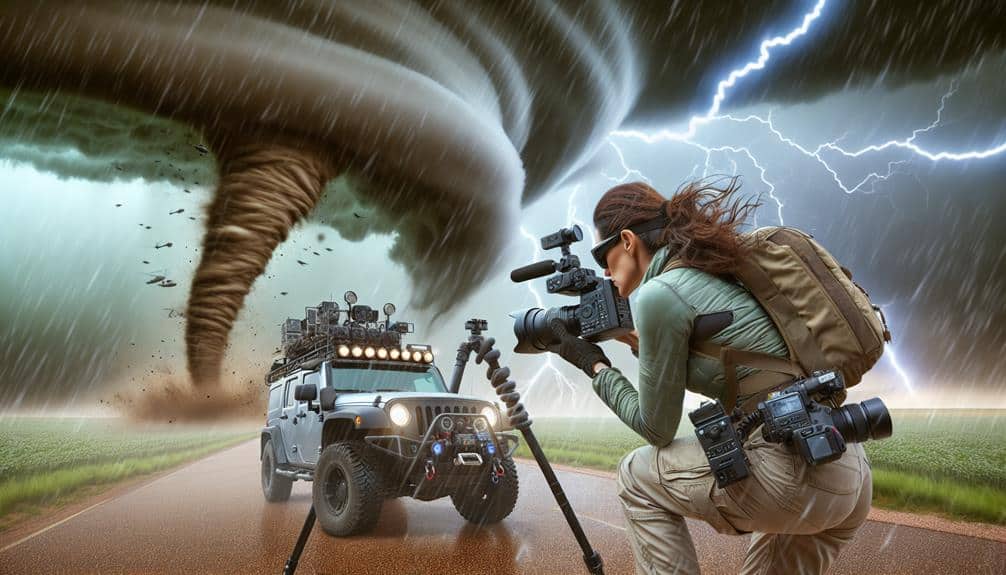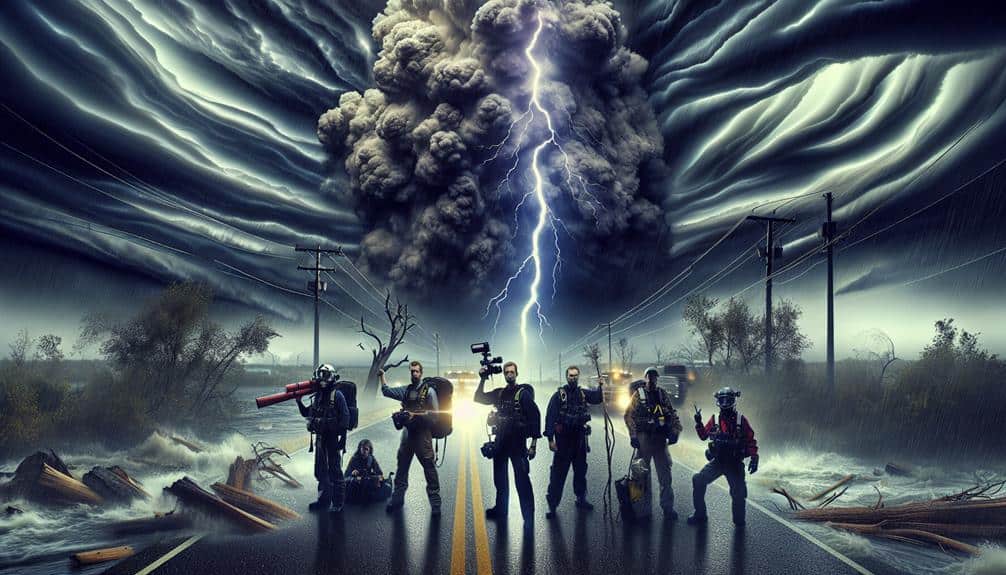As storm chasers, we must acknowledge how climate change affects storm dynamics. Severe storm frequency has increased by about 20% in the last ten years, which is connected to higher atmospheric moisture levels and stronger wind shear. Increasing global temperatures and heightened atmospheric moisture have a significant effect on storm formation and intensity. Monitoring changes in storm paths and coastal impacts, primarily due to rising sea levels, is vital. Utilizing advanced forecasting tools like high-resolution radar and satellite imagery improves our tracking and safety. By examining these factors and improving our methodologies, we can better predict storm behaviors and guarantee readiness for changing storm scenarios.
Key Points
- Monitor increasing storm frequency and intensity caused by rising atmospheric moisture and stronger wind shear.
- Analyze historical weather data to track shifts in storm paths due to global temperature rise.
- Utilize high-resolution radar systems and satellite imagery for accurate storm development forecasting.
- Implement advanced monitoring technologies like satellite altimetry to assess storm impacts on coastal infrastructure.
Observing Storm Frequency Changes
Recent data indicate that the frequency of severe storms has increased markedly over the past decade, prompting us to re-evaluate our storm-chasing strategies. By examining extensive climate research, we've observed significant shifts in weather patterns contributing to this uptick.
For those of us passionate about storm chasing, these changes present both challenges and opportunities. Our analysis reveals that storm frequency has surged by approximately 20% compared to previous decades. This data is derived from a thorough study of meteorological records and satellite imagery. The rise in storm frequency can be attributed to several factors, including elevated sea surface temperatures and altered atmospheric circulation patterns.
These findings necessitate a recalibration of our approach to storm chasing. We must adapt by refining our predictive models and optimizing our equipment to ensure both safety and accuracy. Utilizing advanced climate research tools, we can better anticipate storm development and track shifts in weather patterns.
The freedom to chase storms comes with the responsibility to understand these evolving dynamics. By staying informed about climate-induced changes in storm frequency, we can continue to pursue our passion while contributing valuable data to the scientific community.
Noticing Storm Intensity Trends
Alongside the increased frequency of severe storms, we've also observed a notable rise in their intensity, driven by factors such as higher atmospheric moisture content and stronger wind shear. This shift necessitates a deeper storm intensity analysis to understand the climate change implications on our storm chasing strategies.
Data from recent years indicate that extreme weather patterns are becoming more pronounced. Hurricanes, for instance, now exhibit higher maximum sustained winds and more intense rainfall. Our storm intensity analysis reveals that the added moisture in the atmosphere, due to rising sea surface temperatures, fuels these storms, making them more destructive.
As storm chasers, adapting to these changes is critical. We've had to recalibrate our equipment and refine our predictive models to account for the increased variability in storm behavior. Understanding these climate change implications allows us to anticipate the evolving patterns and adjust our storm chasing strategies accordingly.
Real-time data collection and advanced analytics have become indispensable tools for maneuvering these more severe weather events.
Analyzing Temperature Variations
We observe that rising global temperatures greatly influence storm formation and intensity, necessitating a thorough analysis of temperature variations to refine our storm chasing methodologies.
Temperature anomalies, defined as deviations from a baseline climatological average, play a pivotal role in storm dynamics. By leveraging climate modeling, we can better predict these anomalies and their impact on storm behavior.
Analyzing temperature variations involves examining surface and atmospheric temperatures over time. Data from satellite observations, weather stations, and climate models provide us with insights into how these temperatures fluctuate.
For instance, an increase in sea surface temperatures can fuel more intense tropical storms by providing additional moisture and energy. On land, higher temperatures might destabilize atmospheric conditions, leading to stronger thunderstorms.
Our approach focuses on identifying patterns and correlations between temperature anomalies and storm occurrences. By integrating historical data with advanced climate modeling, we can predict potential hotspots for severe weather. This empowers us to plan our storm chasing routes more effectively, ensuring both safety and the opportunity to capture valuable data.
Tracking Shifts in Storm Paths
We need to analyze historical weather data to understand the influence of climate change on shifts in storm paths. By examining patterns and anomalies in past data, we can develop predictive models for future storm trends.
This approach provides us with analytical insights essential for adapting our storm chasing strategies.
Analyzing Historical Weather Data
By meticulously analyzing decades of historical weather data, we've identified significant shifts in storm paths that correlate with rising global temperatures. This historical analysis is pivotal for understanding the impact of climate change on storm chasing. We've observed that as global temperatures increase, storm systems exhibit altered trajectories, potentially affecting their intensity and frequency.
Our examination of weather data from the past 50 years reveals that storms are migrating poleward, a trend consistent with climate change predictions. This poleward shift challenges traditional storm chasing regions, requiring us to adapt our strategies. For example, tornado alley in the United States is experiencing a noticeable eastward drift.
In addition, our data-driven approach indicates an increase in storm intensity, particularly in regions previously considered low-risk. This necessitates the integration of advanced modeling techniques to accurately track and anticipate these changes. We've leveraged historical analysis to refine our predictive models, ensuring that our storm chasing efforts remain both safe and effective.
Understanding these shifts not only enhances our storm chasing experiences but also contributes to broader climate research. By continuously analyzing historical weather data, we can better navigate the evolving landscape shaped by climate change, ensuring that we remain at the forefront of this dynamic field.
Predicting Future Storm Trends
Leveraging advanced climate models, our team aims to predict future storm trends by meticulously tracking shifts in storm paths and their potential impacts. By integrating data from satellite imagery, Doppler radar, and historical climate records, we analyze evolving storm behavior. This allows us to pinpoint alterations in storm intensity and trajectory, providing actionable insights.
Our focus on climate patterns reveals that increasing sea surface temperatures and shifting jet streams are pivotal factors. These elements contribute to more frequent and severe storms, often diverting traditional storm paths. For instance, we've observed that hurricanes are now reaching higher latitudes, impacting regions previously considered safe.
Quantitative models underscore the correlation between rising global temperatures and storm intensity. We utilize ensemble forecasting to evaluate multiple scenarios, enhancing our predictive capabilities. Each model run refines our understanding of potential storm paths, enabling us to anticipate deviations with greater accuracy.
Freedom to chase storms safely hinges on our ability to predict these future trends. By staying ahead of storm behavior, we not only enrich our experiences but also contribute to broader safety measures.
Embracing this data-driven approach, we align our passion with scientific rigor, ensuring we're prepared for what lies ahead.
Monitoring Sea Level Impacts

We must acknowledge the data indicating rising coastal flood risks due to sea level rise.
This phenomenon exacerbates the frequency and intensity of storm surges, altering storm patterns prominently.
Rising Coastal Flood Risks
How much have rising sea levels intensified coastal flood risks, necessitating advanced monitoring techniques to mitigate impacts?
Over the past century, sea levels have risen approximately 8-9 inches, mainly due to thermal expansion and melting ice caps. This escalation in sea levels has placed coastal infrastructure at notably higher risk. We need to adopt cutting-edge monitoring technologies, such as satellite altimetry and tide gauges, to accurately track and respond to these changes.
Increased flood risks undermine community resilience, making it essential to integrate adaptive strategies into urban planning.
For instance, enhanced flood modeling and real-time data analytics can help predict potential flood zones, allowing for preemptive measures like improved drainage systems and elevated construction. By leveraging Geographic Information Systems (GIS), we can identify vulnerable areas and prioritize resource allocation, ensuring that the most at-risk communities receive immediate support.
Proactive monitoring isn't just a technical necessity; it's a lifeline for those living along coastlines.
As sea levels continue to rise, we must remain vigilant, continuously updating our strategies to counteract the growing threats. This approach not only safeguards lives but also preserves the freedom and stability of our coastal communities.
Altered Storm Patterns
Recent shifts in storm patterns, influenced by rising sea levels, demand thorough monitoring to understand their full impact and devise effective mitigation strategies. As sea levels increase, storm behavior becomes more unpredictable, necessitating real-time data collection and advanced modeling techniques. We must employ satellite imagery, oceanic sensors, and weather radars to track these changes accurately.
Climate shifts are altering the intensity and frequency of storms, with warmer ocean temperatures fueling more powerful hurricanes and typhoons. Analyzing historical data reveals a noticeable increase in Category 4 and 5 storms over the past few decades. This trend underscores the urgency for our monitoring systems to be both exhaustive and adaptive.
We need to focus on coastal regions where sea level rise exacerbates storm surges, leading to more severe flooding. Using Geographic Information Systems (GIS), we can map vulnerable areas and predict potential impacts with greater precision. Enhanced data analytics enable us to translate raw data into actionable insights, facilitating better preparedness and response strategies.
Understanding Atmospheric Moisture
Atmospheric moisture, quantified as humidity, plays an essential role in storm formation and intensity, directly influencing the behavior of storms pursued by chasers. When we examine humidity trends, we notice that increased atmospheric moisture contributes to more energetic storm systems.
Data indicates that global warming has led to a rise in sea surface temperatures, which in turn elevates humidity levels. This increase in moisture is a critical factor in the development of more severe weather phenomena.
Analyzing precipitation patterns, we find that areas with higher humidity levels are experiencing more frequent and intense rainfall events. This shift impacts storm chasers by altering the predictability and behavior of storms.
For instance, supercells and mesoscale convective systems thrive on high moisture content, making them more vigorous and potentially more destructive. Our ability to interpret these patterns allows us to better anticipate the development and path of storms, thereby enhancing our strategic planning.
Utilizing Advanced Forecasting Tools

Advancements in forecasting tools have revolutionized our ability to predict storm behavior with enhanced accuracy and detail. We now have access to sophisticated technology enhancements that improve our weather tracking capabilities, allowing us to make more informed decisions when storm chasing.
High-resolution radar systems, satellite imagery, and computer models provide real-time data, which improves forecasting precision.
Using these tools, we can pinpoint storm development, intensity, and trajectory with exceptional precision. For instance, Doppler radar technology enables us to observe wind patterns within storms, aiding in the early detection of tornadoes. Satellite data offers detailed views of storm systems from space, giving us a better understanding of their structure and movement.
Additionally, numerical weather prediction models simulate atmospheric conditions, incorporating vast amounts of data to predict future weather scenarios.
Adapting to Rapid Weather Changes
As storm chasers, we've had to enhance our monitoring of weather patterns using advanced meteorological data to track rapid changes accurately.
Our emergency preparedness plans now integrate real-time data utilization to anticipate and respond to volatile conditions swiftly.
These adaptive strategies are critical in mitigating risks and ensuring safety during increasingly unpredictable storm events.
Monitoring Weather Patterns
We're closely tracking evolving weather patterns using advanced radar systems and satellite data to adapt swiftly to rapid changes in storm activity. Satellite imagery provides us with real-time visuals, allowing us to monitor storm formations and movements with remarkable accuracy. By integrating this data with sophisticated climate models, we gain insights into potential storm paths and intensities. These models consider a plethora of variables, including atmospheric pressure, temperature gradients, and humidity levels, enabling us to predict and respond to weather anomalies effectively.
Climate change has introduced new complexities to storm patterns, making our reliance on high-resolution data more crucial than ever. We use this data to identify shifts in storm frequency, duration, and intensity. For instance, increased sea surface temperatures can energize storms, resulting in more severe weather events. By analyzing trends over time, we can adjust our strategies to make sure we're always a step ahead.
Our commitment to monitoring weather patterns isn't just about collecting data; it's about interpreting it to make informed decisions. This approach empowers us to navigate the uncertainties brought on by a changing climate, guaranteeing that we can continue to chase storms safely and efficiently.
Emergency Preparedness Plans
Our emergency preparedness plans hinge on real-time data and predictive analytics to swiftly adapt to rapid weather changes, guaranteeing our safety during storm-chasing expeditions. Leveraging meteorological models and historical storm data, we systematically develop evacuation routes and identify the most secure shelter locations. This approach guarantees we can make immediate, informed decisions when faced with sudden shifts in weather patterns.
We prioritize robust communication plans. Each team member is equipped with reliable devices capable of maintaining connectivity in extreme conditions. We establish a network of emergency contacts, including local authorities and meteorologists, to receive critical updates and relay our status. This redundancy bolsters our resilience against communication breakdowns, which are common in severe weather scenarios.
To enhance our preparedness, we simulate various emergency scenarios, analyzing the response efficacy of our plans. This continual refinement process is driven by data analytics and real-world feedback, ensuring we remain agile and adaptive.
Real-Time Data Utilization
Leveraging real-time data is pivotal for adapting to the rapid weather changes we encounter during storm-chasing expeditions. As climate change intensifies, the atmospheric conditions driving severe storms have become increasingly unpredictable. By integrating cutting-edge technology, we can perform precise data analysis, enabling us to make informed decisions on the fly.
Utilizing advanced radar systems and satellite imagery, we continuously monitor storm development. Mobile apps and software platforms that provide live updates on wind speeds, humidity levels, and pressure changes are indispensable. These tools allow us to track storm trajectories and anticipate shifts in weather patterns with remarkable accuracy.
Furthermore, integrating data from IoT devices, such as weather stations and sensors, enhances our ability to capture hyper-localized information. This granular data is vital for understanding microclimates that could influence storm behavior. By harnessing machine learning algorithms, we can analyze vast datasets in real-time, identifying trends and anomalies that might otherwise go unnoticed.
Incorporating this real-time data and technology integration into our storm-chasing strategies grants us the freedom to navigate dynamic environments safely and efficiently. Through meticulous data analysis, we not only enhance our safety but also contribute valuable insights to the broader scientific community studying climate change impacts.
Documenting Case Studies

In examining case studies, we analyze specific instances where climate change has directly influenced the frequency, intensity, and patterns of storms documented by storm chasers. By conducting case study comparisons, we can identify trends and anomalies in storm behavior. These impact assessments serve as critical tools for understanding how our storm chasing strategies need to evolve.
For instance, let's take the 2011 Joplin tornado as a baseline. Comparing it with recent events, we've observed a marked increase in storm intensity and unpredictability. Climate change adaptation becomes essential as we see shifts in storm tracks and durations. By meticulously documenting these changes, we can refine our approaches to chasing and data collection.
Furthermore, the data reveals that storms aren't only becoming more frequent but also more erratic in their paths. This necessitates the development of advanced predictive models and real-time adjustments in our storm chasing strategies. We adapt by integrating cutting-edge technology and continuously updating our methodologies based on the latest findings.
Our analytical insights derived from these case studies empower us to chase more safely and effectively, while contributing valuable data to the broader scientific community. Understanding the evolving nature of storms in a changing climate is paramount for both our safety and the advancement of meteorological knowledge.
Enhancing Safety Protocols
To enhance safety protocols, we must meticulously analyze data from past storm chasing incidents and implement advanced technologies to mitigate risks. By examining incident reports and near-misses, we can identify patterns and common pitfalls. This data-driven approach allows us to refine safety precautions and develop more sturdy risk assessment models.
Leveraging cutting-edge technology, such as real-time weather monitoring systems and predictive analytics, we can stay ahead of rapidly changing storm conditions. Utilizing GPS tracking and mobile communication networks, we ensure that every team member remains accounted for and can respond swiftly to evolving threats. Additionally, drone technology offers a safer alternative for capturing storm data without exposing ourselves to direct danger.
We also need to focus on continuous training and simulation exercises. By incorporating virtual reality (VR) simulations, we can recreate a variety of storm scenarios, enhancing our ability to make quick, informed decisions in the field. This proactive strategy not only sharpens our skills but also ingrains essential safety precautions.
Frequently Asked Questions
How Can Amateur Storm Chasers Get Started in Storm Chasing?
To get started in storm chasing, we need to prioritize safety precautions and gain extensive weather knowledge. Effective risk management and precise storm tracking are essential. Our analytical insights guarantee we make informed decisions while embracing the thrill of freedom.
What Gear Is Essential for Storm Chasing?
To investigate the theory visually, we need essential equipment like radar, GPS, and cameras. Safety precautions include helmets, first-aid kits, and reliable communication devices. We guarantee our data-driven insights keep us safe and informed.
How Do Storm Chasers Communicate With Each Other in Real-Time?
We communicate in real-time using mobile apps and radios to share weather updates and emergency protocols. These tools guarantee we're informed and coordinated, enhancing our ability to monitor storm patterns and make data-driven decisions swiftly.
Are There Any Ethical Concerns Related to Storm Chasing?
We must consider ethical implications in storm chasing, ensuring safety precautions are prioritized. Data shows that reckless behavior endangers lives and property. Analyzing these aspects is essential for maintaining freedom and minimizing negative impacts on communities.
What Training or Education Is Recommended for Aspiring Storm Chasers?
We recommend meteorology courses and safety training as essential for aspiring storm chasers. Understanding weather patterns and engaging in emergency response protocols provide critical skills for maneuvering storms safely while contributing valuable data to scientific research.


